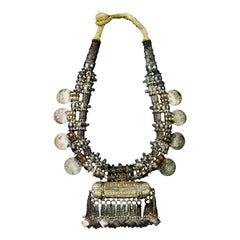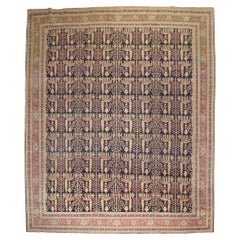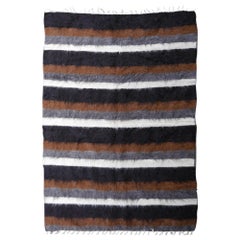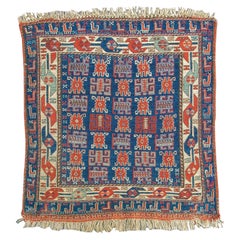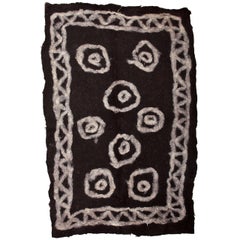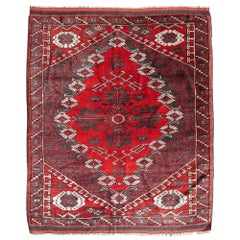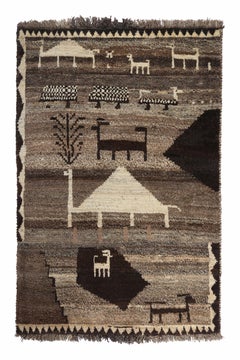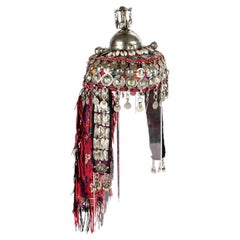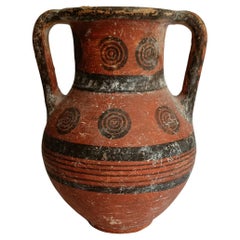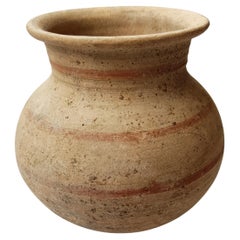West Asian Tribal Art
to
4
19
10
29
1
1
14
14
7
3
2
1
27
25
3
2
2
68,525
764
629
367
194
29
29
29
Place of Origin: West Asian
Oman, Silver & Gold Necklace with Amulet Box, 19th Century
Located in PARIS, FR
Stunning and rare Omani tribal necklace in gold and silver featuring eight Burgau thalers dated 1780 and a large amulet box (Hirz) also in gold and silver. 19th century.
Very good condition. Preserved and professionally framed.
Dimensions of the necklace: 52 x 30 x 3
Dimensions of the frame: 70 x 47 x 5
Secure shipping.
This fine Omani necklace of silver and gold comprises two strands of spiky, seed pod-like silver beads; gold-wrapped beads; eight silver Maria Theresa thaler coins; and a large silver and gold amulet box, with multiple chain tassels each of which finishes with a square-shaped pendant cut from sheet silver.
The cigar-shaped amulet box called hirz would have contained some Koranic verse or religious text.
Such a spectacular display of wealth would only have been worn at times of important festivities such as marriage celebrations.
Maria Theresa thalers were made in Austria since the reign of Empress Maria Theresa of the Austro-Hungarian Empire. The Empress died in 1780 and since that time, all thalers that were subsequently struck were minted with that date regardless of the actual year that they were produced. The coins achieved such a level of trust for their silver content (which is 83.3% silver) in the Middle East that neither the design not the date was varied, and so for more than 200 years the coins were used as an international currency among the tribes and the states of the Middle East, in much the same way as the Spanish dollar was used as an international currency at the time elsewhere. The thalers were used to complete most important transactions locally and were also given as dowries. They were also an important source of silver and were melted locally for jewellery.
The coins made their way to the ports of the Red Sea, Egypt and northern Africa from the ports of Genoa, Trieste, Livorno and Marseille. European traders used the coins to buy precious materials from the Gulf and northern Africa which it desired – commodities such as spices, coffee, gum Arabic, indigo, pearls, and tortoise shell.
The importance and the beauty of the coins saw them incorporated into local jewellery most particularly in Oman and Yemen.
References
Al-Jadir, S., Arab & Islamic Silver, Stacey International, 1981.
Harrigan, P., ‘Tales of a Thaler’, Saudi Aramco World, January/February 2003.
Hawley, R., Omani Silver, Longman, 1978.
Hawley, R., Silver: The Traditional Art of Oman, Stacey International, 2000.
Rajab, J.S., Silver Jewellery of Oman, Tareq Rajab Museum, 1998.
Ransom, M., Silver Treasures from the Land of Sheba: Regional Yemeni Jewelry...
Category
19th Century Antique West Asian Tribal Art
Materials
Gold, Silver
Zabihi Collection Antique Tabriz Willow Tree Rug
Located in New York, NY
1920s Persian Tabriz Rug with a weeping willow tree design on a slightly worn dark field
Details
rug no. j3181
size 10' 1" x 14' 6" (307 x 442 cm)
Category
Early 20th Century Bakshaish West Asian Tribal Art
Materials
Wool
Vintage Mohair Blanket Kilim Rug Turkey Beige Brown Grey Djoharian Collection
Located in Lohr, Bavaria, DE
This is an example of the rare and hard to find tribal Mohair blankets. The bottom side is straight woven like a Kilim, the upper side has wool standing out of the blanket. This keep...
Category
20th Century Tribal West Asian Tribal Art
Materials
Mohair
Antique Persian Shahsevan Sumak Bagface, 19th Century
Located in San Francisco, CA
Antique Persian Shahsevan Sumak Bagface, 19th Century
Using a saturated and subtly modulated medium-blue ground this large Shahsevan sumak bag face draws a creative reinterpretation...
Category
19th Century Antique West Asian Tribal Art
Materials
Wool
Vintage Black Tribal Felt Rug
Located in Milan, IT
Felts are among the first woolen structures made by mankind, some of the earliest we know were found in the 'kurgans' of Central Asia, decorated by a variety of zoomorphic motifs typ...
Category
20th Century Tribal West Asian Tribal Art
Materials
Wool
Rare Antique Bergama Kiz Rug Turkey Red Grey
Located in Lohr, Bavaria, DE
This is an example of the rare and hard to find tribal Turkish Bergama Kiz rugs. The color is often referred to as Turkish red. The condition is very good with vibrant colors.
Berga...
Category
20th Century Tribal West Asian Tribal Art
Materials
Wool
19th Century Small Wooden/Metal Mortar from Yemen/Saudi Border
Located in Chicago, IL
19th century small wooden/metal Mortar from Yemen/Saudi Border.
Category
19th Century Antique West Asian Tribal Art
Materials
Metal
Antique Rugs Blue Caucasian Kazak Rugs, Geometric Carpet Livingroom Rug
Located in Wembley, GB
Kazak rugs have primarily been produced as village productions rather than city pieces. Made from materials particular to individual tribal provinces and the rugs of the Caucasus typically display bold geometric designs in primary colours. Kazak rugs are a type of Armenian rug...
Category
Late 19th Century Kazak Antique West Asian Tribal Art
Materials
Wool, Natural Fiber, Organic Material
Anatolian Ornate Design Handwoven Wool Kilim Rug
Located in New York, NY
Ornate handwoven flat-weave kilim rug with natural pigment dyed wool. The designs woven in to the rug are all symbolic that have been passed done through generations of weavers for h...
Category
20th Century West Asian Tribal Art
Materials
Wool
Antique Grain Sack 'Open' Rug
Located in New York, NY
Antique grain sack 'open' rug. An old tribal cargo bag or rug from SW Turkey, opened up, still retaining its original carrying band. Can be a wall-hanging, a...
Category
Early 20th Century West Asian Tribal Art
Materials
Cotton, Goat Hair, Wool
$1,240 Sale Price
20% Off
Kozak Saddlebags
Located in New York, NY
An old tribal bag, originally meant to be carried over the shoulder or the back of a donkey. A very nice example with lots of details.
Can be used in a variety of ways - wall hangin...
Category
1960s Tribal Vintage West Asian Tribal Art
Materials
Brocade, Goat Hair, Wool
$774 Sale Price
20% Off
Early Anatolian Kilim Fragment
Located in Milan, IT
A stunning early Kilim from Central Anatolia distinguished by a rare apricot background, by a spectacular array of early colors including aubergine and by a bottom compartment decorated by stylized carnations (or Mother Goddess fertility figures...
Category
1750s Kilim Antique West Asian Tribal Art
Materials
Wool
Shepherd's Tulu Hand Knotted Wool Rug Coat
Located in Milan, IT
An original Anatolian Tulu pile rug hand knotted with natural, undyed wool and tailored into a coat. This was used by the shepherds inhabiting the area of Karapinar, in central Anato...
Category
1930s Tribal Vintage West Asian Tribal Art
Materials
Wool
Vintage Samarkand Suzani, Uzbekistan Embroidered Textile Red and Black
Located in North Hollywood, CA
Vintage Samarkand Suzani, Uzbekistan embroidered textile red and black
Tashkent Suzani from Samarkand Uzbekistan, 1950.
Overall good condition for its age and use some stains.
"Suzani" means needlework and these embroideries are some of the most characteristic forms of textile art from Central Asia. The mastery of color and the dynamic sense of movement they convey continue to add depth and joy to contemporary interiors. A high level of creative variation and the individuation of each flower are what make each piece unique.
Measures: 67.5" x 57".
The Silk Road Bukhara: Like scattered pearls along the vast expanse of the Great Silk Road, the cities of Uzbekistan glisten radiantly under the unforgiving sun. This nation, nestled in a picturesque oasis, holds a treasure trove of historical artifacts, owing to its advantageous position at the heart of the ancient Silk Road network. In the year 138 BC, a transformative era commenced as China graciously opened its borders to trade, giving rise to caravans that embarked upon this illustrious route. These trading pathways served as conduits not only for the exchange of goods and craftsmanship but also for the intermingling of cultures, beliefs, and wisdom. Even today, within the ancient walls of cities like Samarkand, one can still discern the echoes of bustling voices, the melodious jingle of camel harnesses...
Category
Early 20th Century Folk Art West Asian Tribal Art
Materials
Fabric
Antique Northwest Persian Bagface, c. 1900
Located in San Francisco, CA
Antique Northwest Persian Bagface Bag, c. 1900
Kurdish weaving is often enigmatic. While Kurdish weavers were certainly influenced by the larger weaving traditions, be it Persian or...
Category
Early 20th Century West Asian Tribal Art
Materials
Wool
$320 Sale Price
20% Off
Antique Rugs Caucasian Kazak Rugs, Blue Geometric Hand made Carpet
Located in Wembley, GB
Kazak rugs have primarily been produced as village productions rather than city pieces. Made from materials particular to individual tribal provinces and the rugs of the Caucasus typ...
Category
Early 20th Century Kazak West Asian Tribal Art
Materials
Wool, Natural Fiber, Organic Material
Antique Persian Baluch Bagface, Late 19th Century
Located in San Francisco, CA
Antique Persian Baluch Bagface Rug, Late 19th Century
Additional information:
Dimension: 2'9" W x 3'0" L
Origin: Persia
Period: Late 19th Century
Condition: Good condition with a s...
Category
Late 19th Century Antique West Asian Tribal Art
Materials
Wool
Vintage Kurdish Polychrome Wool Flat-Weave Rug
Located in Milan, IT
Perdehs were used as tent dividers by the Kurdish tribes of Eastern Anatolia. Each flat-woven wool panel is individually dip-dyed and subsequently hand-stitched to the other panels. ...
Category
1930s Minimalist Vintage West Asian Tribal Art
Materials
Wool
Antique Bakhtiari Sumak Bagface, 19th Century
Located in San Francisco, CA
Antique Persia Bakhtiari Sumak Bagface, 19th Century
Flat woven bags executed in various sumak techniques were crucial items for Persian and Caucasian nomads as they traveled with t...
Category
19th Century Antique West Asian Tribal Art
Materials
Wool
Antique Persian Pictorial Malayer Rug, Wall Hanging, King of Persia Handmade Rug
Located in Port Washington, NY
Antique Persian pictorial Malayer rug, wall hanging fine Persian wool rug showing the story of the King of Persia, signed and handmade rug. Size: 4'6" x...
Category
Early 20th Century Malayer West Asian Tribal Art
Materials
Wool
$7,999 Sale Price
20% Off
Antique Persian Afshar Bagface, Late 19th Century
Located in San Francisco, CA
Antique Persian Afshar Bagface Bag, Late 19th Century
This charming Afshar bag face uses rich saturated vegetable colors and soft glossy wool, with rows of alternating flowers and b...
Category
Late 19th Century Antique West Asian Tribal Art
Materials
Wool
Antique Persian Qashqai Bagface, 19th Century
Located in San Francisco, CA
Antique Persian Qashqai Bagface Bag, 19th Century
The drawing has remarkable clarity. An earlier generation of this design. Killer color, with deep aubergine and blue-green.
Dimens...
Category
19th Century Antique West Asian Tribal Art
Materials
Wool
Horse Saddle Rug with an Idea
Located in Alessandria, Piemonte
nr. 1316 - It's a good old saddle rug, simple with its hex-proof pendants: pleasant to rest on the back of the sofa.
But it can become the seat of an armch...
Category
Early 20th Century Other West Asian Tribal Art
Materials
Wool
Antique Persian Baluch Bagface, Late 19th Century
Located in San Francisco, CA
Antique Persian Baluch Bagface Bag, Late 19th Century
Additional information:
Dimension: 2'6" W x 2'6" L
Condition: Good, minor moth damage.
Origin: Persia
Period: Late 19th Centur...
Category
Late 19th Century Antique West Asian Tribal Art
Materials
Wool
Antique Persian Shahsevan Sumak Bagface, 19th Century
Located in San Francisco, CA
Antique Shahsevan Sumak Bagface, 19th Century
Against a deep modulated indigo ground, rows of delicate flowering shrubs are elegantly drawn in the field of this Northwest Persian su...
Category
19th Century Antique West Asian Tribal Art
Materials
Wool
Antique Persian Luri Bakhtiari Flatwoven Salt Bag in Cotton, c. 1900
Located in San Francisco, CA
Antique Southwest Persian Luri Bakhtiari Flatwoven Cotton Salt Bag, c. 1900
This Luri-Bakhtiari salt bag is a graphic delight. A central cruciform element is drawn in white cotton a...
Category
19th Century Antique West Asian Tribal Art
Materials
Cotton
Red Afshar Sumak Salt Bag, Late 19th Century
Located in San Francisco, CA
Red Afshar Sumak Salt Bag, Late 19th Century
A central white diamond is highlighted in white cotton on this Afshar salt bag. Throughout the field, geometric scarab-like elements ar...
Category
Late 19th Century Antique West Asian Tribal Art
Materials
Wool
Antique Anatolian Bergama Heybe Bags, Late 19th Century
Located in San Francisco, CA
Antique Anatolian Turkish Bergama Heybe Bags Rug, Late 19th Century
Additional Information:
Dimensions: 1'8" W x 4'2" L
Origin: Anatolia (Turkey)
Period: Late 19th Century
Rug ID: 1...
Category
Late 19th Century Antique West Asian Tribal Art
Materials
Wool
Antique Persian Afshar Bagface, c. 1900
Located in San Francisco, CA
Antique Persian Afshar Bagface Bag, c. 1900
This highly graphic Afshar bag face draws a large central indigo-blue hexagon against a complimentary contrasting terra cotta field. Both...
Category
19th Century Antique West Asian Tribal Art
Materials
Wool
Related Items
Vintage Gabbeh Tribal Rug in Beige-Brown, Grey Pictorial Pattern by Rug & Kilim
Located in Long Island City, NY
This vintage 3x5 Gabbeh Persian rug is from the latest entries in Rug & Kilim’s rare tribal curations. Hand-knotted in wool circa 1950-1960.
On the Design:
This tribal provenance i...
Category
1950s Tribal Vintage West Asian Tribal Art
Materials
Wool
$1,920 Sale Price
20% Off
W 41 in L 59 in
Turkoman Tribal Ceremonial Headdress
Located in Bridgeport, CT
A stitched colorful fabric hat with applied silver tone roundels, plaques and pendants, bells and cowrie shells. The long back flap with a triangular Turkoman pendant with glass rou...
Category
Mid-20th Century Tribal West Asian Tribal Art
Materials
Other, Metal
Tribal Style Songye Kifwebe Mask, D. R. Congo
Located in Point Richmond, CA
This graphic Songye Kifwebe mask has fine carved lines curved over the eyes and diagonal lines radiating from the nose and mouth in classic Kifwebe form. ...
Category
Late 20th Century Tribal West Asian Tribal Art
Materials
Wood
extremely rare Algerian Judaica silver, jewish Dowry box early 19th century
Located in Tel Aviv - Jaffa, IL
Amazing and scarce JUDAICA object, we have here one of the most touching jewish objects we had for a long time, this small silver dowry box was made in Algeria in the early 19th century, it is all covered with symbols of jewish faith and of couples, the sliding lid has 2 flanking birds with hamsa (protective hand) on each side and a flower vase in the middle.
one side shows two flanking lions with a tree in the middle and the other side shows again two big and two small birds with a flower bowl in the middle, front side has a key hole and next to it there is the Hebrew inscription ס״ט״" which says Siman tov or in English "a good sign" it is taken from the wedding blessing, underneath the lock there is another inscription with the name ״עזיזה בת אברהם בן חמו״ which is the name of the bride, her father and her grandfathers name.
the box is full marked a lot of times with the silversmith mark, every side of the box is marked.
this box was probably ordered by the grooms family to hold the jewelry they are giving to the bride as dowry, this type of objects are rare and there are just a few of them on museum collections.
DOWRY (Heb. נְדֻנְיָה), the property a wife brings to her husband at marriage; the Yiddish equivalent, nadn, is from the same root. The custom of nedunyah became clearly defined and institutionalized only in the talmudic period. In biblical times, mohar (מֹהַר), whereby the groom bought his wife from her father (Gen. 24:53; Ex. 22:15–16; Hos. 3:2), was the accepted practice. It was then customary that the groom give the bride gifts, and that she bring certain property to her husband's home upon marriage: slaves, cattle, real estate, etc. (cf. Gen. 24:59–61; 29; Judg. 1:14ff.; I Kings 9:16). Evidence of the custom of nedunyah is to be found in Tobit (7:14; 8:21) and in the Assuan papyri (Cowley, Aramaic, nos. 15, 18). Gradually, mohar was superseded by the ketubbah custom according to which the husband merely assumed the responsibility of compensation to his wife in case he divorced her: he had to pay her 200 zuzim if she had been a virgin at the time of marriage, and 100 zuzim if a widow or divorcée (see *Ketubbah).
By talmudic times, the institution of nedunyah was prevalent; the father gave a dowry to the bride since the daughter was excluded from paternal inheritance. Fifty zuzim (equivalent to the worth of 180 grams of silver) was the minimum amount a father was obliged to give to his daughter (Ket. 6:5). Parents usually gave much more, according to their social standing. Community funds provided the dowry for an orphan or a very poor girl (ibid.; cf. Sh. Ar., YD 251:8). In case of her father's death, the brothers of a minor girl were obliged to give her the minimum dowry, and the court estimated how much her father would have given her above the minimum dowry. The sum was then taken out of the father's estate and given to the daughter upon majority (Ket. 6:6; 68a–69b). In the absence of such an estimate, each daughter was entitled to receive one-tenth of the value of her father's estate in money, or in valuables (Yad, Ishut, 20:4–7; Sh. Ar., EH 113:4). If the father was unable or unwilling to pay the promised dowry at the betrothal ceremony, the groom could refuse to marry his bride (Ket. 13:5; Ket. 108b–109a). Insistence on exact payment of the promised dowry, however, was frowned upon by later rabbinic authorities (Rema to Sh. Ar., EH 2:1). In certain communities it was customary for the groom's father to make a dowry contribution equal to that of the bride's father (Ket. 102b). The dowry, whether given in real estate, slaves, money, or chattel was recorded in the marriage contract (the ketubbah) and in some instances one-third or one-fifth of the actual value of the dowry was added to the sum mentioned in the ketubbah. Based upon a decree enacted by *Simeon b. Shetah (first century C.E.), the Talmud ruled that the husband and his entire property were liable for compensation as stipulated in the ketubbah, either in case he died (when she collected the sum specified in the ketubbah from the heirs) or in case he divorced his wife (Ket. 82b). For the status of the dowry and the husband's rights and obligations, see below. The rabbinic enactments (Takkanot Shum) by R. Jacob *Tam and by the rabbinic synod of the communities of Speyer, Worms, and Mainz (Germany) stipulated that if a woman died...
Category
Mid-19th Century Antique West Asian Tribal Art
Materials
Silver
$15,000
H 2.8 in W 2.8 in D 5.6 in
Antique Persian Tabriz Rug
Located in New York, NY
An early 20th century Persian Tabriz. Since the 17th century, Iran started exporting artisan carpets around the world, especially to Europe. Artists used one of the three versions of...
Category
1920s Tabriz Vintage West Asian Tribal Art
Materials
Wool
19th Century Balinese Temple Offering Tray / Bowl 'Dulang' with Polychrome
Located in Jimbaran, Bali
Balinese offering tray; "Dulangs" served two main purpose, one purpose was to carry offerings atop woman’s heads during ceremonies. The present "Dulang" was used exclusively in temples to display offerings and features hints of turquoise polychrome at its base. This "Dulang" has faded polychrome and chipped...
Category
Mid-19th Century Other Antique West Asian Tribal Art
Materials
Wood
$785
H 16.54 in Dm 18.51 in
Collection of 19th Century Wooden Bowls
Located in Los Angeles, CA
14 diameter x 4 high. These three butter bowls were found in New England and are all in fine condition. Sizes are as listed and sold as a collection of three.
Measures: 10 diameter ...
Category
Mid-19th Century Other Antique West Asian Tribal Art
Materials
Wood
Vintage Moroccan Brown Plum Tribal Berber Rug
By Berber Tribes of Morocco
Located in North Hollywood, CA
Vintage Tribal Moroccan Berber rug, different hues of browns, plum and rust natural organic wo.This carpet is a gorgeous piece of Abstract Modernist Art...
Category
Late 20th Century Folk Art West Asian Tribal Art
Materials
Wool
Tribal Textile, Kuba Shoowa 20th Century
Located in Point Richmond, CA
An example of the continuation of the Kuba design tradition into the late 20th century. Technically superb, an amalgamation of traditional patterns interpreted by contemporary artist...
Category
Late 20th Century Tribal West Asian Tribal Art
Materials
Natural Fiber
Vintage Kilim rug in Beige, Brown Striations by Rug & Kilim
Located in Long Island City, NY
A 5x7 vintage kilim rug from our flatweave selections, originating from Turkey circa 1960-1970. Handwoven in all wool, the rug features a distinctive panel-woven style playing beige-...
Category
1960s Tribal Vintage West Asian Tribal Art
Materials
Wool
Rare Silver Balangandãs - 20th Century Brazilian Native Hanging Amulet
Located in Rio De Janeiro, BR
Mid 20th century brazilian silver hanging amulet from native culture in Brazil. Known as "Penca de Balangandãs" was used in the ancient times as an amul...
Category
Mid-20th Century Other West Asian Tribal Art
Materials
Sterling Silver
Tribal Textile, Kuba Shoowa 20th Century
Located in Point Richmond, CA
A late 19th or early 20th century Kuba Prestige cloth, mostly embroidered with cut pile borders.
Category
Early 20th Century Tribal West Asian Tribal Art
Materials
Natural Fiber
Previously Available Items
Ancient Cypriot Bichrome Ware Amphora – Black-on-Red Pottery ca. 800–600 BC
Located in London, GB
Ancient Cypriot Bichrome Ware Amphora – Black-on-Red Pottery, Cypro-Archaic, ca. 800–600 BC
A beautifully preserved ancient Cypriot bichrome ware amphora dating to the Cypro-Archaic...
Category
15th Century and Earlier Antique West Asian Tribal Art
Materials
Pottery
H 6.3 in W 4.73 in D 4.73 in
Antiquities Ancient world Cypriot pottery bowl Middle East Antiques
Located in London, GB
A ancient Greek Cypriot pottery bowl
Buff pottery of globular form with pointed small base with painted bands of colour
Early Iron age C 1000 500 BC...
Category
15th Century and Earlier Antique West Asian Tribal Art
Materials
Pottery
Pair of Antique Shahsavan Sumak Bags, 19th Century
Located in San Francisco, CA
Pair of Antique Shahsavan Sumak Bags, 19th Century
This pair of sumak bags was most likely woven in the Karabagh region of the South Caucasus. A central medallion, composed of sever...
Category
19th Century Antique West Asian Tribal Art
Materials
Wool
Antique Shahsevan Sumak Bagface, 19th Century
Located in San Francisco, CA
Antique Caucasian Shahsevan Sumak Bagface Rug, 19th Century
From the Collection of Dr. Charles Whitfield.
Additional Information:
Dimensions: 2'5" W x 2'5" L
Origin: Caucasus
Perio...
Category
19th Century Antique West Asian Tribal Art
Materials
Wool
Antique Persian Qashqai Bagface, Late 19th Century
Located in San Francisco, CA
Antique Persian Qashqai Bagface, Late 19th Century
A colorful bag face with excellent color, the design is rather common. Its attributes include clarity of color and contrasting sha...
Category
Late 19th Century Antique West Asian Tribal Art
Materials
Wool
Antique Kurdish Bagface, Late 19th Century
Located in San Francisco, CA
Antique Kurdish Bagface Bag, Late 19th Century
Additional information:
Dimension: 1'9" L x 1'4" W
Origin: Northwest Persia
Period: Late 19th Century
Rug ID: 19592
Category
Late 19th Century Antique West Asian Tribal Art
Materials
Wool
Antique Persian Afshar Bagface, 19th Century
Located in San Francisco, CA
Antique Persian Afshar Bagface Bag, 19th Century
The design pool of pile rugs and bags from South Persia often conform to known groups of motifs, but the patterns seen here do not. ...
Category
19th Century Antique West Asian Tribal Art
Materials
Wool
Arabian Indian Bedouin Horse Hair Bone and Sterling Fly Whisk with Horn Handle
Located in Los Angeles, CA
Arabian Bedouin Fly Whisk with Horn Handle - While the piece has a practical side, the whisk is also great for carrying to outdoor events where there maybe mosquitos or flys.
A love...
Category
19th Century Antique West Asian Tribal Art
Materials
Cut Steel
Superb Antique Yemeni Saudi Arabian Khanjar Jambiya Dagger Silver Islamic Arts
Located in London, GB
A Rare Large Antique Jambiya Dagger with highly ornate silver work with added gold gilding
A superb example of a middle eastern Jambiya
Height 3...
Category
Late 19th Century Antique West Asian Tribal Art
Materials
Silver, Gold Leaf
H 14.97 in W 5.91 in D 1.19 in
Double Nomadic Saddlebag or Newspaper Holder
Located in Alessandria, Piemonte
nr. 201 - Antique Turkish nomadic double saddlebag in perfect conditions. The two central strips were used to hold it steady on the saddle -tree.
Placed on an easel or the armrest o...
Category
Mid-20th Century Other West Asian Tribal Art
Materials
Wool
Late 19th to Early 20th Century Silver Anklets, Oman
Located in Point Richmond, CA
Late 19th to early 20th century silver Anklets, Oman
These silver anklets were fashioned in India for the Omani market. Made of repousse silver over a wood frame, they open with a central screw pin. This pair is in wonderful worn condition - an important addition to any ethnographic jewelry...
Category
Late 19th Century Tribal Antique West Asian Tribal Art
Materials
Silver
Rare Elaborate Traditional Wool Turkish Camel Saddle
Located in Los Angeles, CA
Unique Camel Dynasty riding saddle with handwoven wool rug cover. Striking red, green, gold and ivory.
Two wood handles.
Measures 21.5 H x 20” W x 18” depth.
Category
Early 20th Century West Asian Tribal Art
Materials
Wool, Silk, Wood
